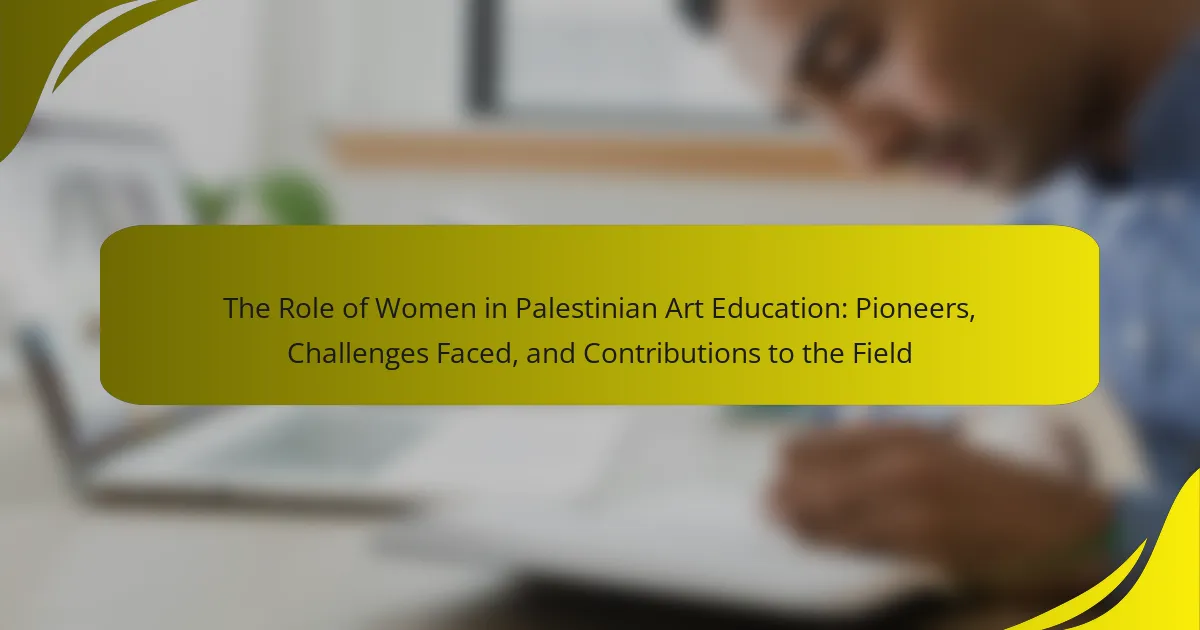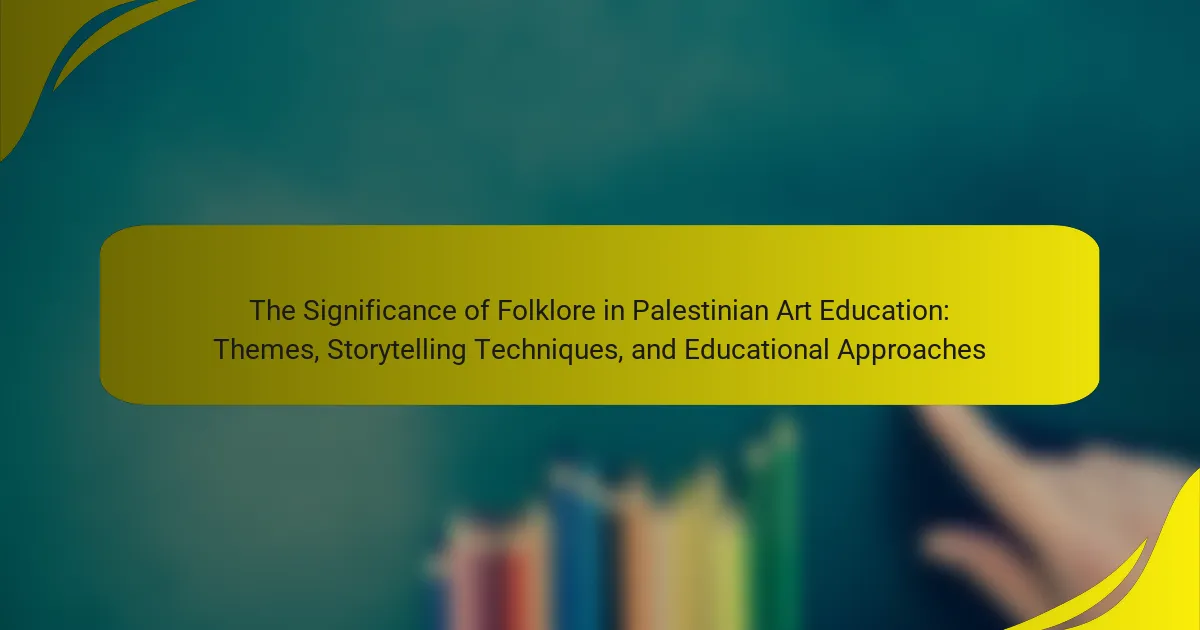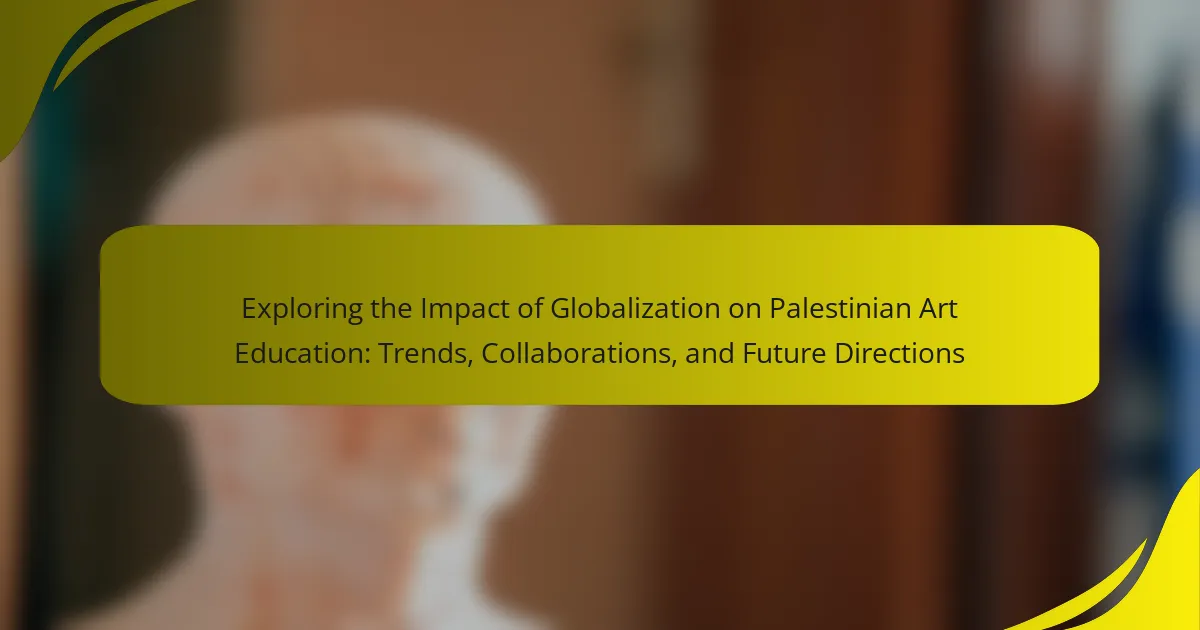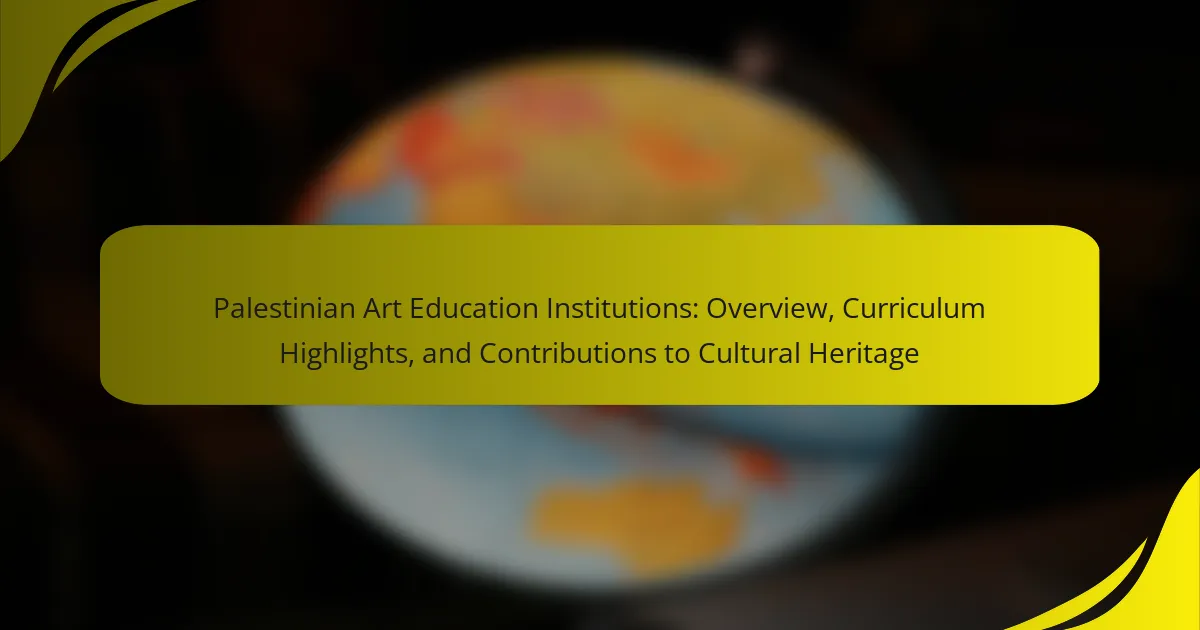Digital media significantly enhances Palestinian art education by improving accessibility and student engagement. It provides a platform for students to explore various artistic techniques and concepts, facilitating collaboration among artists and educators across different regions. With access to an array of resources such as tutorials and virtual exhibitions, students can cultivate their creativity and innovation. Research highlights that the integration of digital media not only boosts student motivation and participation but also aids in the preservation and promotion of Palestinian cultural heritage through digital storytelling. This article examines the tools, innovations, and educational outcomes associated with the use of digital media in Palestinian art education.
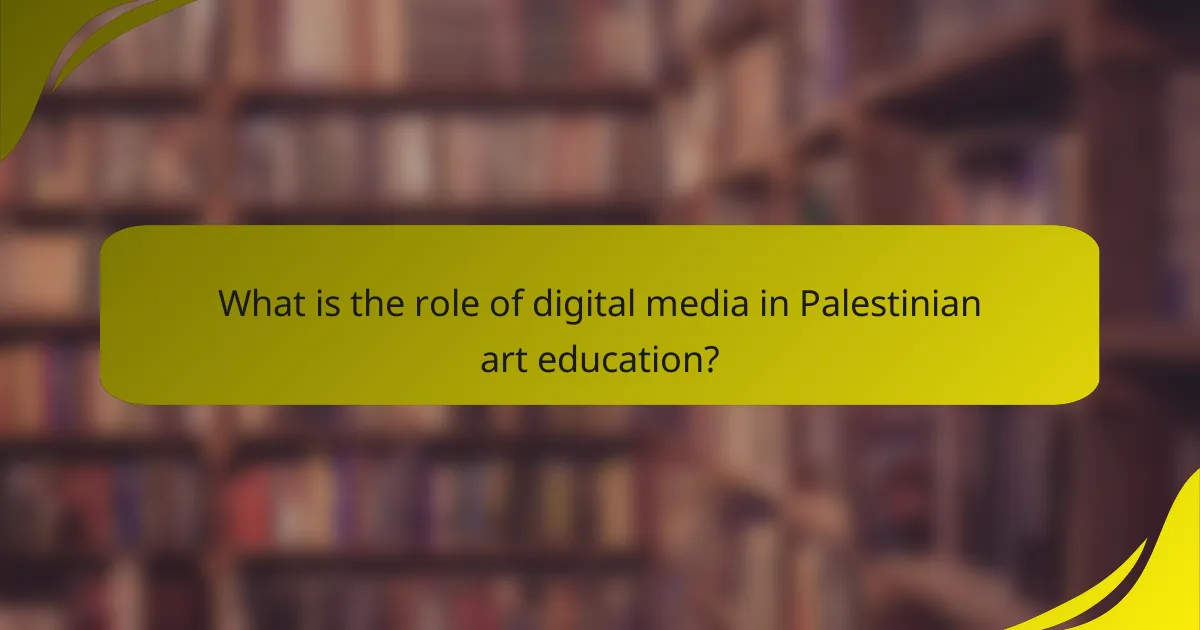
What is the role of digital media in Palestinian art education?
Digital media plays a crucial role in Palestinian art education by enhancing accessibility and engagement. It allows students to explore diverse artistic techniques and concepts through online platforms. Digital tools facilitate collaboration among artists and educators, breaking geographical barriers. Students can access a wealth of resources, including tutorials and virtual exhibitions. This engagement fosters creativity and innovation in their artistic practices. Research indicates that integrating digital media increases student motivation and participation in art education. Additionally, it supports the preservation and promotion of Palestinian cultural heritage through digital storytelling.
How has digital media transformed traditional art education in Palestine?
Digital media has significantly transformed traditional art education in Palestine by enhancing accessibility and engagement. It allows students to access diverse artistic resources online. Digital platforms enable collaboration among artists and educators across geographic boundaries. Virtual workshops and tutorials provide learning opportunities that were previously unavailable. Social media facilitates the sharing of student artwork, fostering a sense of community. Additionally, digital tools enhance creative expression through various software applications. Research indicates that this shift has led to improved educational outcomes in art programs. The integration of digital media in classrooms has made art education more relevant to contemporary practices.
What specific digital tools are being utilized in Palestinian art education?
Palestinian art education utilizes various digital tools, including graphic design software, online collaboration platforms, and digital drawing tablets. Graphic design software like Adobe Photoshop and Illustrator allows students to create and manipulate visual art. Online collaboration platforms such as Google Workspace enable students and educators to share resources and feedback effectively. Digital drawing tablets provide artists with a versatile medium for creating digital illustrations. These tools enhance creativity and facilitate remote learning, particularly in challenging environments. The integration of these digital tools reflects a growing trend in art education to embrace technology for improved artistic expression and collaboration.
How do these tools enhance artistic expression among students?
Digital media tools enhance artistic expression among students by providing diverse platforms for creativity. These tools allow for experimentation with various art forms, such as digital painting, animation, and graphic design. Students can easily manipulate colors, shapes, and textures, fostering innovation in their work. Access to online resources and tutorials enables skill development and inspiration. Collaboration features in digital tools encourage peer feedback and collective projects. Furthermore, these tools facilitate the sharing of artwork on social media, expanding audience reach. Research indicates that students using digital media report increased engagement and motivation in their artistic pursuits. This engagement leads to improved self-expression and confidence in their abilities.
What innovations have emerged in Palestinian art education through digital media?
Innovations in Palestinian art education through digital media include enhanced access to resources and interactive learning experiences. Digital platforms facilitate collaboration among artists and educators across geographical barriers. Virtual galleries and online exhibitions showcase Palestinian art globally, increasing visibility. Mobile applications provide art tutorials and workshops, making learning more accessible. Social media serves as a space for community engagement and feedback. These innovations foster creativity and critical thinking among students. Research by the Arab Educational Information Network highlights the positive impact of digital tools in expanding educational opportunities in the region.
What are the most impactful digital platforms used by art educators in Palestine?
Art educators in Palestine primarily use platforms like Facebook, Instagram, and YouTube. These platforms facilitate sharing artwork and educational content. Facebook groups serve as community spaces for discussion and collaboration. Instagram allows for visual storytelling and showcasing student work. YouTube provides access to tutorials and educational videos. Research indicates that these platforms enhance engagement and creativity among students. They also support remote learning initiatives, especially during challenging circumstances.
How do these innovations influence student engagement and creativity?
Innovations in digital media significantly enhance student engagement and creativity in art education. These tools provide interactive platforms that foster collaborative learning. For example, students can share their artwork online, receiving immediate feedback from peers and educators. This real-time interaction promotes a sense of community and encourages creative risk-taking. Furthermore, digital media allows for diverse forms of expression, such as video, animation, and digital painting. Research by the National Art Education Association indicates that students using digital tools show increased motivation and creativity. The use of multimedia resources also caters to various learning styles, making art education more inclusive. Overall, these innovations create a dynamic learning environment that inspires and engages students effectively.
What educational outcomes are associated with the use of digital media in art education?
The use of digital media in art education leads to enhanced creativity and critical thinking skills. Students engage with technology to create original artworks. This interaction fosters innovative problem-solving abilities. Additionally, digital media enables collaboration among students. They can share their work and receive feedback in real-time. Research shows that students using digital tools exhibit higher engagement levels. A study by the National Art Education Association found that digital media integration improves artistic expression. This results in a deeper understanding of art concepts and techniques. Overall, digital media in art education promotes both skill development and artistic exploration.
How do digital media tools improve learning outcomes for art students?
Digital media tools enhance learning outcomes for art students by providing interactive and engaging learning experiences. These tools facilitate access to a wide range of resources, including tutorials and online galleries. Art students can experiment with various digital techniques that may not be feasible in traditional settings.
Research indicates that digital media fosters creativity and innovation among students. A study by the Journal of Educational Technology found that students using digital tools demonstrated improved artistic skills and conceptual understanding. Additionally, collaborative platforms enable peer feedback and community engagement, enriching the learning process.
Overall, digital media tools support personalized learning, allowing students to progress at their own pace. They also prepare students for modern artistic practices, aligning education with industry standards.
What skills do students develop through the integration of digital media?
Students develop various skills through the integration of digital media. These skills include critical thinking, creativity, and collaboration. Digital media encourages students to analyze information critically. They learn to evaluate sources and discern credible content. Creativity is enhanced as students create digital art and multimedia projects. Collaboration skills are fostered through group projects using digital platforms. Additionally, students improve their technical skills with software and digital tools. Research shows that these skills are essential for success in the modern workforce. For instance, a study by the National Education Association highlights the importance of digital literacy in education.
How does the integration of digital media in art education address local challenges?
The integration of digital media in art education addresses local challenges by enhancing accessibility and engagement. Digital tools allow students in remote or underserved areas to access quality resources and instruction. This technology bridges gaps in traditional educational infrastructure. For instance, online platforms enable collaboration with artists and educators worldwide. Additionally, digital media fosters creativity by providing diverse forms of expression. It accommodates various learning styles, making art education more inclusive. Research shows that students using digital media demonstrate increased motivation and improved skills. This approach effectively addresses the specific challenges faced in Palestinian art education, such as limited resources and geographic barriers.
What are the barriers to implementing digital media in Palestinian art education?
Barriers to implementing digital media in Palestinian art education include limited access to technology and internet connectivity. Many educational institutions lack the necessary infrastructure to support digital tools. Economic challenges also hinder the acquisition of digital resources. Additionally, there is a lack of training for educators in utilizing digital media effectively. Cultural factors may influence the acceptance of digital methods in traditional art practices. Political instability further complicates the situation, affecting consistent access to educational resources. These barriers collectively restrict the integration of digital media in the curriculum.
What best practices can enhance the effectiveness of digital media in art education?
Integrating interactive elements enhances the effectiveness of digital media in art education. Interactive tools engage students actively, promoting deeper understanding. Utilizing platforms like virtual galleries allows for immersive experiences. Incorporating multimedia resources caters to diverse learning styles. Regularly updating content keeps the material relevant and engaging. Providing clear instructions ensures students can navigate digital tools effectively. Encouraging collaboration through online forums fosters community and peer feedback. Research shows that these practices lead to improved student outcomes in creative disciplines.
How can educators effectively incorporate digital tools into their curriculum?
Educators can effectively incorporate digital tools into their curriculum by integrating technology that enhances learning experiences. This includes using multimedia presentations and interactive software that engage students. Platforms like Google Classroom facilitate collaboration and resource sharing among students and teachers. Digital art tools allow for creative expression and skill development in art education. Research shows that incorporating digital tools can improve student engagement and learning outcomes, as evidenced by studies highlighting increased participation rates. Moreover, utilizing online resources enables access to a broader range of information and perspectives. Training educators in these tools ensures they can maximize their potential in the classroom.
What strategies can be used to assess the impact of digital media on student learning?
Surveys and questionnaires effectively assess the impact of digital media on student learning. These tools gather students’ feedback on their experiences and perceptions. Pre- and post-tests can measure knowledge gained through digital media use. This method provides quantifiable data on learning outcomes. Observational studies allow educators to see how students engage with digital media in real-time. Analyzing student performance metrics offers insights into academic improvement linked to digital media. Focus groups can provide qualitative data on student attitudes and engagement. Implementing case studies can illustrate specific instances of digital media’s impact. These strategies collectively offer a comprehensive assessment of digital media’s role in learning.
The main entity of this article is digital media in Palestinian art education. The article explores the significant role of digital media in enhancing accessibility, engagement, and collaboration among students and educators in Palestine. It discusses various digital tools utilized in art education, highlights innovations that have emerged, and examines the impact of these tools on student creativity and learning outcomes. Additionally, the article addresses the barriers to implementing digital media and provides best practices for educators to effectively incorporate these tools into their curriculum. Overall, it emphasizes the transformative effect of digital media on artistic expression and education in Palestine.
